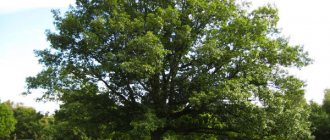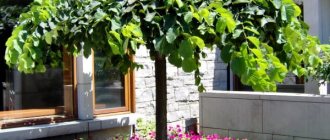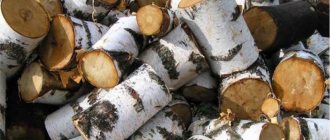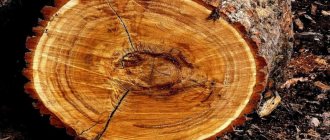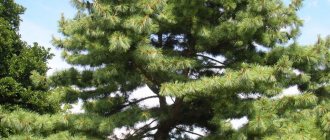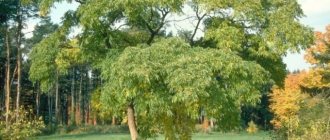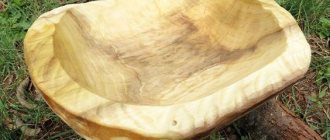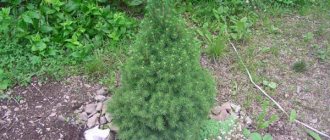Without requiring special attention to itself, the willow fully responds to the care shown to it - with a chic crown, a graceful bend of weeping branches and a light silver haze of leaves. Willows are extremely common and very famous plants in central Russia.
Most species of willows love humidity and settle in damp places; relatively few species grow in dry places (on slopes, sand, etc.) and in swamps. Willow is also found in forests, as a mixture of other trees.
Willow (Salix) are trees and shrubs of the willow family (Salicaceae). Common name: willow, shelyuga, willow, tall, willow, willow, vine, willow.
Description of the willow tree
The willow appeared on earth quite early, its remains can be found already in the Cretaceous formation, and even modern species lived in the Quaternary era: white willow (Salix alba), ashy willow (Salix cinerea), twig willow (Salix viminalis).
The willow genus includes at least 350 species, distributed mainly in the cool regions of the Northern Hemisphere, where the willow extends beyond the Arctic Circle. Several species of willows grow in the tropics.
There are more than 65 species in North America, of which only 25 reach tree size. Most willows are small trees from 10 to 15 meters in height or shrubs, however there are willows that are 30 to 40 meters high and have a diameter of more than 0.5 meters.
In cold countries, willows grow far to the north; these are very low-growing dwarf willows: Reticulated willow (Salix reticulata), Dull-leaved willow (Salix retusa), Herbaceous willow (Salix herbacea), Polar willow (Salix polaris).
In the mountains there grow low-growing willows (Salix herbacea) and others that reach the very snowy border. Polar and alpine willows are low-growing creeping shrubs - up to several centimeters in height.
Their interspecific hybrids are often found. Various types of willow, as previously noted, are called: shelyuga, willow, willow, willow (large trees and shrubs, mainly in the western regions of the European part of Russia); vine, willow (shrub species); tal, talnik (mainly shrub species, in the eastern regions of the European part, in Siberia and Central Asia).
Thanks to the ability to produce adventitious roots, willows can be freely propagated by cuttings and even stakes (with the exception of Salix caprea - goat willow). Seeds lose their viability within a few days; Only the five-stamen willow (Salix pentandra) seeds retain their viability until next spring.
Where is it found?
The growing area is very wide. Europe, Asia (Western part), Siberia, Iran are familiar with the varieties of Silver Willow firsthand. For the Russian central zone it is a completely common tree with cultivated decorative subspecies and varieties.
It is found in abundance along the banks of large and small bodies of water, forming extended pure or mixed groves. Lonely trees are not uncommon. Prefers moist soils and in the absence of water reservoirs nearby. Dwarf willow is easy to find in mountainous areas. And you can see shrub specimens in Central Asia and Siberia.
Planting willow in open ground in spring
To plant a seedling of shrubby willow species, you need to dig a hole 50x50 cm, for tall trees of slightly larger sizes - 60x60 cm and a depth of 40 cm. (When planting large-sized plants with a large lump of earth, the hole must be 40-50 cm wider than the lump itself, and the depth accordingly 30-40 cm more). Fill it with a soil mixture (from 1/3 to 1/2 of the volume of the hole), which will consist of soil, compost or quail manure and peat in a ratio (1: 1: 1).
If the soil is heavy, then sand is added to the soil (up to 20%). In addition, for willow it is necessary to apply complex mineral fertilizers, for example, azofoska (from 150 to 200 grams). Mix the soil mixture in the hole well. When planting a hedge or dense alley, it is advisable to dig a trench 40-50 cm wide and 40 cm deep.
Willow with a closed root system takes root well at any time of the year - from April to October (the main thing is that the lump and roots are not overdried). But bare-rooted plants are best planted in early spring, before buds open, or in September, with the beginning of leaf fall. When planting in autumn, the leaves of the seedling must be removed. Low-winter-hardy species and varieties do not need to be planted in winter, since their fragile roots and shoots can die from frost before they have time to develop.
Prune the plant correctly
5 meters
maximum tree height
Experts on their channel told how to care for the Weeping Gnome variety.
- Do not form the crown until it reaches the height you need. The willow must grow so that when it forms there are enough shoots left so that after pruning there are not only a few branches left.
- To limit height, trim the top shoot. This stimulates the growth of lateral branches and the crown becomes denser and more voluminous.
- If you are forming a tree with a small crown, then cut off the shoots on the trunk in early spring. This way you will get rid of unwanted branches and cause minimal damage to the tree, since sap flow has not yet begun.
Video: formation of the crown of the dwarf willow Gnome
Weeping willow care
In the first season after planting, willow needs abundant watering: from 20 to 50 liters of water (depending on the size of the plant) once every two weeks and every week during the dry period. Then moderate irrigation will be enough for her. Shrub species that form a hedge need to be trimmed once or twice a season (in spring and mid-summer).
As for feeding, complex fertilizers are applied two or three times during the spring and summer, and at the end of August - superphosphate and potassium sulfate. In rainy years, gray and black spots often appear on willow leaves, similar to a dirty coating. In order to restore the tree to its original beauty, you need to spray it with copper oxychloride (CHOM) or oxychome.
In autumn, it would be good to remove fallen leaves from the area. Grafted trees must be cleared of wild growth in summer or autumn. We must not forget about sheltering non-winter-hardy varieties. This is done in October - early November.
How to decorate a willow garden?
In gardens and parks, willows are usually traditionally planted on the banks of a reservoir. And this is quite understandable - a natural landscape, a familiar image. But, of course, such a plastic and unusually impressive tree will decorate any corner of the garden, and its crown will protect you from the scorching sun.
Willows, planted at intervals of 1.5-2 meters, form a high hedge, and in two rows - a shady alley. The alley is especially beautiful from the weeping white willow when the trees close their crowns. To do this, already in the second or third year after planting, branches directed towards each other are intertwined at a height of 2.5 to 3 meters or connected using ablation. Ablation is a grafting method used to connect shoots of one or different plants without cutting them.
True, this method requires special skills, so the easiest way is to braid the branches by securing both tops with thin plastic tape. After the closure of the willow branches, a green openwork tunnel is obtained. And if there is no room in the garden for an alley, then you can limit yourself to a green arch at the entrance - just two trees.
Shrub willows (purple willow, climbing willow, Caspian willow) are a delightful material for hedges. They will shade and at the same time decorate a children's or sports ground. But no less picturesque are the bushes, simply planted in a row or in several clumps along the garden path. And how interesting dwarf or weeping willows look in a rock garden, especially if there is a stream flowing nearby or a small fountain gushes.
However, a lone willow on a wide lawn surrounded by flowering ornamental shrubs or in the company of coniferous plants, whose prickly beauty only benefits from such a contrast, is also impressive.
Variety of species
All willows can be divided into large ones - for large areas and for small gardens, as well as low shrubby types.
Large size - willows for parks and large gardens
Golden willow "Chrysocoma" (Salix x sepulcralis 'Chrysocoma')
White or silver willow (Salix alba) and brittle willow (Salix fragilis)
They can be found along roadsides, ditches, and in meadows. They are usually large and look very picturesque. This is a beautiful, magnificent tree with a wide crown.
Brittle willow is a medium-sized tree, reaching a height of up to 20 meters, with an exceptionally wide, dome-shaped crown and a short trunk growing up to a meter in diameter. It has dark brown bark and fairly thick branches. The leaves are thin, lanceolate and grow up to 16 cm in length. Their upper parts are shiny and dark green, while their undersides are blue-green. A characteristic feature of this willow is its soft and brittle wood. Hence the name. In spring, the tree is covered with yellow-green flowers.
Types, varieties and forms of willow: photo with name and description
There are more than 350 species of willows in the world of various shapes and sizes - from mighty twenty-meter giants to creeping shrubs several centimeters high. More than a hundred of them are in our country (there are about 20 species in the middle zone alone).
White willow (willow)
White willow (willow)
- The shape is silver. The tallest (from 10 to 12 m) and the most unpretentious of the decorative willows. It got its name due to the spectacular silver color of the leaves. Delightful in parks - against the backdrop of dense dark green foliage of large trees: horse chestnut, elm, linden. And planted in the background (along the fence line), these willows with their silvery foliage emphasize the beauty of red-leaved maples, plums, barberries or the dark needles of mountain pine and yew.
- The form is weeping. The tree is 5 to 7 m high, with an extremely beautiful cascading crown and long (2 to 3 m) branches reaching almost to the ground. It is unpretentious to the soil, winter-hardy, and moisture-loving. Tolerates shade, but in the absence of sun the crown is not so dense and not so decorative. Weeping willow is good both on its own and in a small group of trees, especially along the banks of reservoirs. Perfectly combined with flowering and decorative deciduous shrubs and low conifers: juniper, thuja, cypress.
Brittle willow (broom)
Brittle willow (broom)
- The shape is spherical. The crown is very dense, regular spherical or dome-shaped. The tree is multi-stemmed, sometimes reaching a height of 7 m. It does not freeze even in cold winters. Delightful both in single and group plantings, it can serve as a good background for other ornamental plants. A small clump or string of such willows is especially picturesque on the shore of a reservoir. Rakita is also used as a hedge.
Goat willow
Goat willow
- The form is weeping. Extremely spectacular, with weeping shoots arranged in a “tent” at the top of a small, usually one and a half meter, trunk. Recently, it has become popular thanks to the foreign planting material that has appeared in our country. In good light, the tree forms a narrow, tent-shaped crown with shoots hanging vertically down, sometimes right down to the ground. In spring, they are densely covered with fluffy flowers, turning the trees into large dandelions. It hardly grows upward, exceeding the height of the trunk by only 30-40 cm. It is planted in groups. But one tree is also beautiful against the background of plants with a different shade of foliage or at the turns of garden paths. They care for goat willow in the same way as any standard grafted plant. First of all, it is necessary to promptly remove the wild growth that forms on the stem under the grafting site (below the base of the weeping shoots at the top of the stem), otherwise the grafted part may simply die off. Since this type of willow is not very winter-hardy, it should be planted in well-lit areas protected from the wind. In the northern Moscow region, it is better to cover the grafted part of the seedling for the winter by wrapping it in several layers of non-woven material. When planting, standard plants need to be tied to three stakes in order to maintain verticality.
Willow tortuous
Willow tortuous
- Matsuda form. Golden spiral-shaped shoots with slightly curled leaves give it a special charm. Like any beauty, Matsuda's willow is very capricious. A foreigner, she does not tolerate severe frosts well: in the Moscow region and more northern regions, in severe winters she is frozen to the level of snow, so she needs to be covered. This willow is planted only in illuminated places well protected from the wind. But even under ideal conditions in the Moscow region, the height of the plant rarely exceeds 3-3.5 m.
- Ural twisted. No less attractive than Matsuda, but better adapted to the Russian climate. The tree is not tall (up to 3.5 m), but very decorative, and at any time of the year. Its spiral-shaped greenish-gray shoots appear glossy brown in the sun. Regardless of the season, it tolerates pruning and trimming well, so it is suitable for hedges. Thanks to its twisted shoots and twisted “curly” leaves, this willow is a delight to the eye, both on its own and surrounded by other willow trees.
Willow whole leaf
Willow whole leaf
- Variety "Hakuro-Nishiki". An extremely interesting type of willow with snow-white leaves at the end of the shoots and variegated leaves in the middle and closer to the base of the branches. It grows as a low bush (up to 1.5 m) or a low tree - when grafted onto a standard. Disadvantage: low winter hardiness. In the middle zone, it is better to plant non-standard seedlings and cover the plants for the winter.
Purple willow
Purple willow
- A medium-sized shrub, up to 2-2.5 m high, with a dense, almost spherical crown and glossy reddish shoots. In recent years, this species has become more and more popular in Russia. Shade-tolerant, but not very winter-hardy. After freezing it grows back easily; it is not necessary to cover it for the winter. It is better to plant in places protected from the wind.
Caspian willow
Caspian willow
- A spreading three-meter tall willow shrub with thin long shoots of pale yellow color and narrow, hard leaves. Shade-tolerant, but not very winter-hardy. After freezing it grows back without difficulty; there is no need to cover it for the winter. It is better to plant in places protected from the wind.
Plant type
The plant loves moisture very much, so it is often planted on the banks of ponds and lakes. It is easy to care for, easily tolerates fairly low temperatures in our country, and reproduces easily. Forms wide dense crowns.
In autumn, the leaves acquire a beautiful yellow color, sometimes with a reddish tint. In spring, cute fluffy inflorescences called “seals” appear on thin branches. They serve as a harbinger of spring.
Experts on their channel told how to care for the Weeping Gnome variety.
- Do not form the crown until it reaches the height you need. The willow must grow so that when it forms there are enough shoots left so that after pruning there are not only a few branches left.
- To limit height, trim the top shoot. This stimulates the growth of lateral branches and the crown becomes denser and more voluminous.
- If you are forming a tree with a small crown, then cut off the shoots on the trunk in early spring. This way you will get rid of unwanted branches and cause minimal damage to the tree, since sap flow has not yet begun.
Willow pests and methods of controlling them
In the general system of measures to increase the productivity of willows on plantations, special attention should be paid to measures to combat diseases and pests.
Most often, willow is damaged by caterpillars of various butterflies, leaf beetles and elephant beetles, aphids, flies, as well as the parasitic dodder plant. The Russian, twig and purple willows suffer the most from insects.
- Poplar leaf beetle. The beetle is 10 to 12 mm long, with reddish elytra and bluish-green pronotum and underside of the body. At the top of the elytra there is one black spot.
- Aspen leaf beetle. The appearance and biology of the aspen leaf beetle are similar to those of the poplar leaf beetle. The beetle is slightly smaller in size than the poplar beetle (length from 7 to 10 mm) and does not have black spots on the elytra.
- Willow silkworm. Most often it affects willow. Leaf roller caterpillars roll the tops of the leaves into a dense cocoon and eat the top of the shoot. The shoot bushes, which is why it loses its technical qualities.
- Common willow aphid. Sucks juice from leaves, buds, and young shoots. Gives 10 generations per year.
Spider mite
Spider mite. Appears on the underside of the leaf and sucks out the juice. If the damage is severe, the leaves turn brown and fall off. In summer the mite is greenish-yellow in color and by autumn it turns reddish-orange in color. Overwinters under bark, fallen leaves and in soil (in the adult female stage).
Bindweed. A weed that causes harm to willow plantations, especially in the first year of life. The bindweed wraps around the rod, leaving traces of spirals on the bark and even on the wood, causing the rods to break during operation. Shoot growth stops.
European dodder. Plant parasite. The dodder sends adventitious roots into the wood of the twig, sucking out nutrients. Often the entire bush dies from dodder.
Willow grass. A butterfly from 20 to 25 mm long with white wings. The caterpillars are hairy, yellow-blue in color with red specks.
Mouse-like rodents damage roots and gnaw planted cuttings.
Variety of species
All willows can be divided into large ones - for large areas and for small gardens, as well as low shrubby types.
Large size - willows for parks and large gardens
Golden willow "Chrysocoma" (Salix x sepulcralis 'Chrysocoma')
This tree has a wide, dense and regular crown. The branches are long, slender and drooping. It is not an independent species and is a hybrid of the Babylonian willow and our native white willow (Vitellina variety) from China. Golden-haired willow is a large, impressive tree with a spreading crown and yellow-barked shoots hanging down to the ground.
White or silver willow (Salix alba) and brittle willow (Salix fragilis)
They can be found along roadsides, ditches, and in meadows. They are usually large and look very picturesque. This is a beautiful, magnificent tree with a wide crown.
Brittle willow is a medium-sized tree, reaching a height of up to 20 meters, with an exceptionally wide, dome-shaped crown and a short trunk growing up to a meter in diameter. It has dark brown bark and fairly thick branches. The leaves are thin, lanceolate and grow up to 16 cm in length. Their upper parts are shiny and dark green, while their undersides are blue-green. A characteristic feature of this willow is its soft and brittle wood. Hence the name. In spring, the tree is covered with yellow-green flowers.
